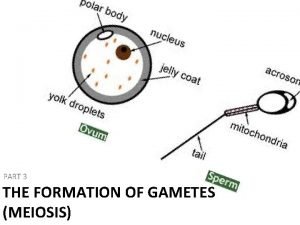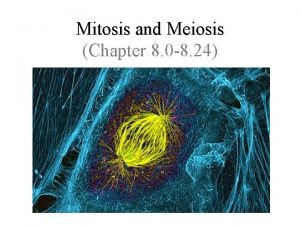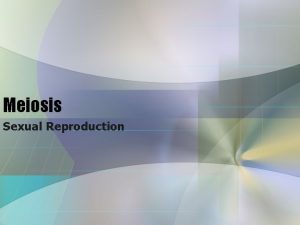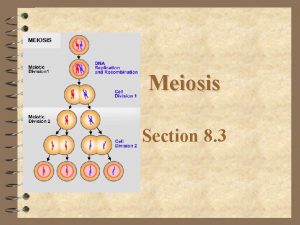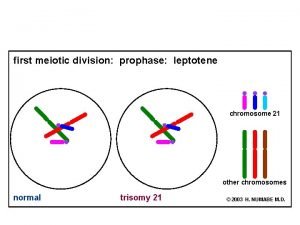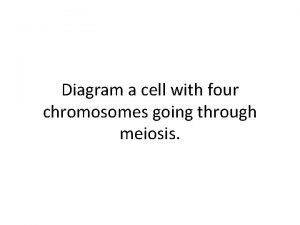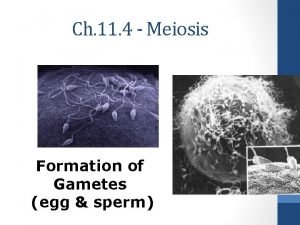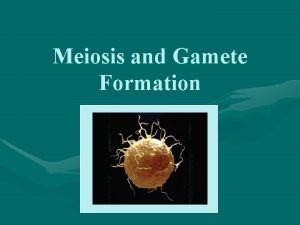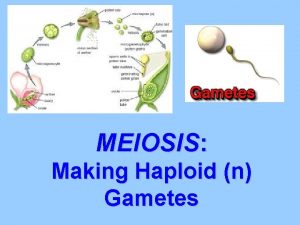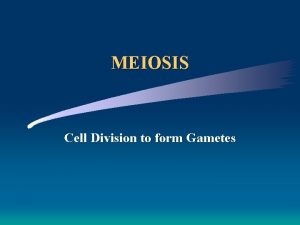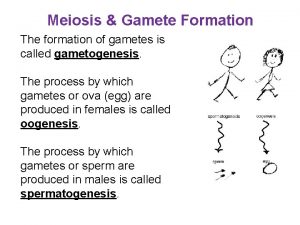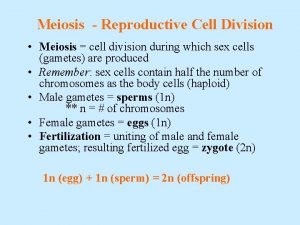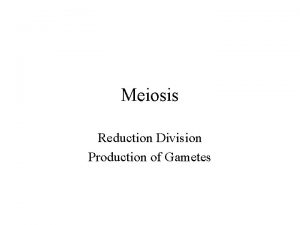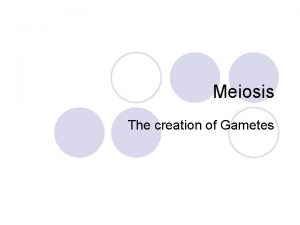MEIOSIS GAMETE CELL DIVISION Recall that GAMETES are










- Slides: 10

MEIOSIS: GAMETE CELL DIVISION • Recall that GAMETES are the REPRODUCTIVE (SEX) cells of the body. • "The BIRDS and the BEES" - The Basics • SEXUAL REPRODUCTION occurs when two different individuals ( 1 male & 1 female) produce a HYBRID OFFSPRING (a combination of both parents) by each contributing 1 GAMETE cell. • Male cell: SPERM CELL • Female cell: EGG CELL • FERTILIZATION occurs when the two cells meet and form ONE new cell called the ZYGOTE. (This is the very FIRST cell of any sexually reproducing organism) • The zygote will then divide OVER AND OVER again VIA MITOSIS until it grows into fully developed individual.

• In order for a sexually reproducing organism's chromosome number to stay the same generation after generation (for example: Humans- 46 chromosomes) the gamete's chromosome number must be HALF of the normal number. • (Human gamete - 23 chromosomes) • To make such cells requires a different type of cell division called MEIOSIS • There are many important SIMILARITIES and DIFFERENCES between MITOSIS & MEIOSIS

SIMILARITIES: • The order of phases ( P > M > A > T ) and major events that occur at each are the same for the most part – PROPHASE- formation of chromosomes, centrioles, & spindle fibers – METAPHASE- chromosomes line up on equator – ANAPHASE- pulling apart of chromosomes – TELOPHASE- separation completes, cytokinesis occurs DIFFERENCES: • Meiosis goes through TWO sets of division (not ONE): MEIOSIS I and II • Meiosis produces FOUR daughter cells (not TWO) • Daughter cells have been reduced to HAPLOID (N) cells (23 chromosomes) instead of DIPLOID (2 N) (46 chromosomes) • Daughter cells are NOT IDENTICAL to the PARENT cell or EACH OTHER

MEIOSIS I: PROPHASE I: Same as prophase of mitosis EXCEPT • Once chromosome are formed, they PAIR UP with their MATCHING COUNTERPART. *REMEMBER! You have 2 copies of each of the 23 chromosomes (1 from mom, 1 from dad), this adds up to make 46 total. • This is called a HOMOLOGOUS PAIR • CROSSING OVER occurs between the homologous chromosomes • (GENES can FLIP-FLOP from one chromosome to its partner) • Crossing over creates endless gene combinations and GREATLY increases GENETIC DIVERSITY

METAPHASE I: Same as metaphase of mitosis EXCEPT. . . • HOMOLOGOUS PAIRS line up in the middle, instead of INDIVIDUAL chromosomes. ANAPHASE I: • SISTER CHROMATIDS are NOT pulled apart • HOMOLOGOUS PAIRS are pulled apart "BUTTERFLIES" are still intact TELOPHASE I: Same as telophase of mitosis EXCEPT. . . • At this point the CHROMOSOME NUMBER has been reduced from 46 to 23 in the daughter cells. (From DIPLOID to HAPLOID)

Meiosis II Anaphase (MITOSIS) • The events that take place in MEIOSIS II are exactly the same as MITOSIS, EXCEPT that there are only 23 chromosomes being separated INSTEAD of 46. Check out this website for a good animation on the difference between Mitosis and Meiosis: http: //highered. mcgraw-hill. com/olc/dl/120074/bio 17. swf http: //www. sumanasinc. com/webcontent/animations/content/mitosis. html http: //www. sumanasinc. com/webcontent/animations/content/meiosis. html

• GAMETOGENESIS: The making of gametes • GAMETE - SEX CELL (SPERM OR EGG) • GENESIS - TO MAKE OR CREATE 2 TYPES: • SPERMATOGENESIS - Makes MALE sperm cells • OOGENESIS - Makes the FEMALE egg cells Both processes use MEIOSIS as their type of cell division, HOWEVER the results are quite different.

SPERMATOGENESIS • Happens in the TESTES • GERM CELLS in the testes are DIPLOID (2 N, 46) just like the rest of the body cells. • Initial germ cells are called PRIMARY SPERMATOCYTES 1 round of spermatogenesis produces FOUR healthy sperm cells. Every sperm cell contains a unique combination of genes. (NO TWO ARE ALIKE!) 2 N Primary Spermatocyte 46 m 1 1 N 23 (1 chromosome = 1 pair of sister chromatids – still connected) Secondary Spermatocytes 23 m 2 23 23 1 N 23 23 Spermatids Mature Sperm Cells

OOGENESIS: • Happens in the OVARIES Primary Oocyte 2 N 46 • GERM CELLS in the ovaries are DIPLOID (2 N, m 1 46) just like the rest of the Secondary Oocytes 23 23 1 N body cells. • Initial germ cells are m 2 called PRIMARY 23 23 1 N 23 1 Ootid 23 OOCYTES • 1 round of Oogenesis produces ONE healthy X X X egg cell (OVUM), and 3 Polar Bodies THREE POLAR BODIES. Mature Egg Cell 23 The polar bodies serve (OVUM) NO PURPOSE in the body. (1 chromosome = 1 pair of sister chromatids – still connected)

Sperm production begins at puberty and continues throughout life. An average of 300, 000 sperm cells are made every day. Females start releasing ONE mature egg every month beginning at puberty and ending at MENOPAUSE (late 40 s to 50 s). Why the difference? ! Why do males make so much sperm and females make so few eggs?

